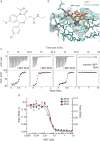Suppression of inflammation by a synthetic histone mimic
- PMID: 21068722
- PMCID: PMC5415086
- DOI: 10.1038/nature09589
Suppression of inflammation by a synthetic histone mimic
Abstract
Interaction of pathogens with cells of the immune system results in activation of inflammatory gene expression. This response, although vital for immune defence, is frequently deleterious to the host due to the exaggerated production of inflammatory proteins. The scope of inflammatory responses reflects the activation state of signalling proteins upstream of inflammatory genes as well as signal-induced assembly of nuclear chromatin complexes that support mRNA expression. Recognition of post-translationally modified histones by nuclear proteins that initiate mRNA transcription and support mRNA elongation is a critical step in the regulation of gene expression. Here we present a novel pharmacological approach that targets inflammatory gene expression by interfering with the recognition of acetylated histones by the bromodomain and extra terminal domain (BET) family of proteins. We describe a synthetic compound (I-BET) that by 'mimicking' acetylated histones disrupts chromatin complexes responsible for the expression of key inflammatory genes in activated macrophages, and confers protection against lipopolysaccharide-induced endotoxic shock and bacteria-induced sepsis. Our findings suggest that synthetic compounds specifically targeting proteins that recognize post-translationally modified histones can serve as a new generation of immunomodulatory drugs.
Conflict of interest statement
Atomic coordinates and structure factors for the BRD4-I-BET crystal structure have been deposited in the RCSB Protein Data Bank under PDB ID code 3P5O. Microarray data has been deposited at the Gene Expression Omnibus (GEO) under the accession number GSE21764. ChIP sequencing data has been deposited under accession number GSE21910. The authors declare competing financial interests.
Figures




Comment in
-
Drug discovery: Reader's block.Nature. 2010 Dec 23;468(7327):1050-1. doi: 10.1038/4681050a. Nature. 2010. PMID: 21179160 No abstract available.
References
Publication types
MeSH terms
Substances
Associated data
- Actions
- Actions
- Actions
Grants and funding
LinkOut - more resources
Full Text Sources
Other Literature Sources
Molecular Biology Databases

